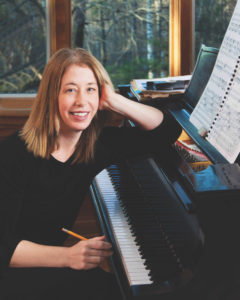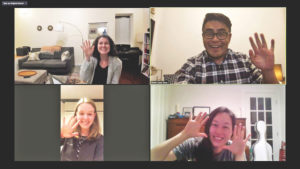
“Begin staggered, play as written, see what happens.” These are the instructions at the beginning of Elena Ruehr’s most recent composition for string quartet. Titled Zoom, it’s intended to be played on the video-conferencing software from which it gets its name.
Ruehr, who lives part of the year in Wellfleet, studied at the University of Michigan and the Juilliard School. She currently teaches music theory at M.I.T. and is a prolific composer, having written for orchestra, wind ensemble, chorus, opera company, and chamber ensemble. Her work has been recorded by the Boston Modern Opera Project. Much of it takes its inspiration from literature or nature.
The inspiration for the Zoom quartet, however, was the cancellation of the premiere of Ruehr’s seventh string quartet, to be performed by the acclaimed Arneis Quartet, due to the coronavirus pandemic. Ruehr was already using Zoom for her online lectures at M.I.T. and wanted to compose a piece that the Arneis could play together while maintaining social distancing. Though writing a piece to be played over Zoom sounds, in theory, like a straightforward task, it is actually far more complicated.
Zoom is one of the most popular platforms for business meetings, university lectures, and, of course, Covid-19-era virtual cocktail parties. But group interfacing with Zoom, as with any video-conferencing software, will occasionally have issues, such as lags or delays. The reason for this is the varying strength of participants’ internet connections, especially considering all the simultaneous audio and video encoding and decoding that Zoom requires.

During meetings or lectures, these pauses in reception are merely awkward or annoying, but when making music, they are infinitely more problematic. Music relies heavily on synchronization. It’s essential that musicians start and stop at the same time, but they also need to stay together throughout so that their parts may interlock like puzzle pieces. What is ingenious about Ruehr’s composition is that it essentially has delays already written into it.
At the beginning of the piece, the first violin starts, followed by the second violin, followed by the viola. Several measures later, the cello enters. The exact timing of these staggered entrances is flexible; Ruehr says the music itself can “float around.” She has written the piece in such a way that if any of the instruments plays a bit early or late, it will still make sense harmonically — that is, it will still sound like music.
The composition, in Ruehr’s words, is “a bit of an experiment.” Because Zoom is designed for voices, it works best with midrange sounds that resemble speech. Sometimes the highest notes of the violin or lowest notes of the cello are clipped. In order to combat this, the musicians listened to each other through Zoom, but recorded themselves on their phones.
Ruehr’s Zoom quartet required some unique adjustments. Playing chamber music usually relies heavily on communication between musicians, including nods and other visual cues, and intakes of breath. These sorts of interactions don’t always come across electronically. Things like rhythm and intonation are also naturally affected. What’s more, Ruehr’s piece, because of its flexible timing, demands a more improvised feeling than most classical music.
“You have to let go of the way you usually play with other people,” says Daniel Doña, violist of the Arneis Quartet. “Once I did that, I was able to have some fun with it.”
Though still a work in progress, Ruehr’s composition is noteworthy, not only because of the way it is constructed and played, but because of what it says about the genre. Historically, chamber music was music that could be played in a small room among a few musicians, with or without an audience. It is intimate music — the last thing you would expect to share online.
By having four musicians playing in four distant and discrete rooms, or “chambers,” Ruehr subverts the expectation of what chamber music is, as well as what physical separation means. But at the same time, her work honors what the string quartet is at its essence: a conversation between instruments. This time, that conversation just happens to be over Zoom.
To listen to Ruehr’s piece, visit the YouTube page for the Arneis Quartet, scroll through the uploads, and click on “Zoom Quartet: Elena Ruehr.”
